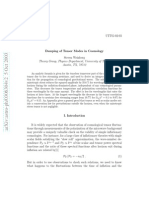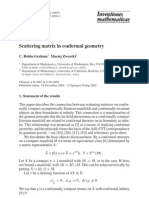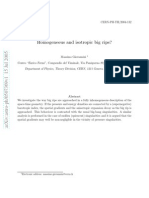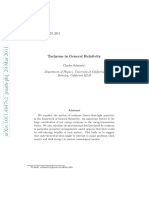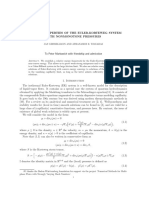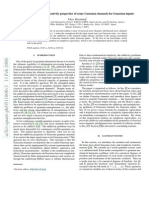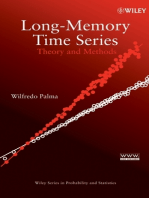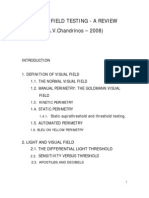Quantum Contributions To Cosmological Correlations II: Can These Corrections Become Large?
Quantum Contributions To Cosmological Correlations II: Can These Corrections Become Large?
Uploaded by
satyabashaCopyright:
Available Formats
Quantum Contributions To Cosmological Correlations II: Can These Corrections Become Large?
Quantum Contributions To Cosmological Correlations II: Can These Corrections Become Large?
Uploaded by
satyabashaOriginal Description:
Original Title
Copyright
Available Formats
Share this document
Did you find this document useful?
Is this content inappropriate?
Copyright:
Available Formats
Quantum Contributions To Cosmological Correlations II: Can These Corrections Become Large?
Quantum Contributions To Cosmological Correlations II: Can These Corrections Become Large?
Uploaded by
satyabashaCopyright:
Available Formats
a
r
X
i
v
:
h
e
p
-
t
h
/
0
6
0
5
2
4
4
v
2
2
2
J
u
n
2
0
0
6
UTTG-03-06
Quantum Contributions to Cosmological Correlations II:
Can These Corrections Become Large?
Steven Weinberg
Theory Group, Department of Physics, University of Texas
Austin, TX, 78712
Abstract
This is a sequel to a previous detailed study of quantum corrections to cos-
mological correlations. It was found there that except in special cases these
corrections depend on the whole history of ination, not just on the behav-
ior of elds at horizon exit. It is shown here that at least in perturbation
theory these corrections can nevertheless not be proportional to positive
powers of the RobertsonWalker scale factor, but only at most to powers of
its logarithm, and are therefore never large.
Electronic address: weinberg@physics.utexas.edu
I. INTRODUCTION
Calculations of non-Gaussian corrections to cosmological correlations in
the classical approximation have shown that these higher-order corrections
are generally suppressed by powers of GH
2
, where G is Newtons constant
and H is the cosmological expansion rate at the time of horizon exit[1].
From the magnitude of the observed Gaussian correlations of uctuations
in the cosmic microwave background, it is known that GH
2
10
12
for
the uctuation wavelengths studied in the microwave background, which
makes the expected non-Gaussian corrections quite small. Quantum eects
involve additional powers of G, and are therefore usually supposed to be
too small to be detected. But a recent paper[2] has shown that it in many
theories these quantum corrections depend on the whole history of ination,
not just on the behavior of elds at horizon exit, raising the possibility that
they may be much larger than usually thought. In particular, if quantum
corrections were to involve positive powers of the RobertsonWalker scale
factor a(t) at the end of ination, then they might be large enough to be
detected. In this paper we will extend the results of reference [2] to a very
large class of theories, and show that (at least in perturbation theory) this
never happens; quantum corrections depend at most on powers of ln a(t),
and therefore (without 10
12
e-foldings after horizon exit) never become
large.
II. SCALARS AND GRAVITATION
We will rst consider a theory of multiple scalar elds
n
(x) and gravita-
tion, slightly more general than that considered in reference [2]. The scalar
Lagrangian is assumed to consist of a conventional minimal kinematic term,
plus a term with arbitrary potential V (). In the Arnowitt-Deser-Misner
formalism[3], the components of the metric are
g
ij
= a
2
e
2
[exp ]
ij
,
ii
= 0 , (1)
g
00
= N
2
+g
ij
N
i
N
j
, g
i0
= g
ij
N
j
, (2)
where a(t) is the RobertsonWalker scale factor,
ij
(x, t) is a gravitational
wave amplitude, (x, t) is a scalar, and N and N
i
are auxiliary elds, whose
time-derivatives do not appear in the action. The Lagrangian density (with
8G 1) is
L =
a
3
2
e
3
_
2NV () +N
1
_
E
j
i
E
i
j
(E
i
i
)
2
_
1
+N
1
n
_
n
N
i
n
_
2
_
Na
2
e
[exp ()]
ij
n
n
+
a
2
Ne
[exp()]
ij
R
(3)
ij
, (3)
where
E
ij
1
2
_
g
ij
i
N
j
j
N
i
_
,
E
i
j
= a
2
e
2
[exp()]
ik
E
kj
, N
i
= a
2
e
2
[exp()]
ik
N
k
, (4)
where
i
is the three-dimensional covariant derivative calculated with the
three-metric e
2
ij
; and R
(3)
ij
is the curvature tensor calculated with this
three-metric. The auxiliary elds N and N
i
are to be found by requiring
that the action is stationary in these variables. This gives the constraint
equations:
i
_
N
1
_
E
i
j
i
j
E
k
k
__
= N
1
n
_
n
N
i
n
_
, (5)
N
2
_
R
(3)
2V a
2
e
2
[exp()]
ij
n
n
_
= E
i
j
E
j
i
_
E
i
i
_
2
+
n
_
n
N
i
n
_
2
. (6)
For our present purposes, all we need to know about R
(3)
ij
, E
i
j
, and the
solutions for N and N
i
is that none of them contain terms with positive
powers of a. We can impose gauge conditions, for instance by setting any
one of the scalar elds equal to its unperturbed value and requiring that
ij
= 0.
The possibility of positive powers of a(t) in correlation functions of the
n
and/or arises from the explicit factors a
3
and a in the terms in Eq. (3). But
these factors can be compensated by negative powers of a(t) in various eld
time derivatives and in various commutators, which arise from the structure
of the perturbative expansion for correlation functions. The expectation
value of any product Q(t) of eld operators at various space points (but all
at the same time t) is [2]
Q(t) =
N=0
i
N
_
t
dt
N
_
t
N
dt
N1
_
t
2
dt
1
__
H
I
(t
1
),
_
H
I
(t
2
),
_
H
I
(t
N
), Q
I
(t)
_
___
, (7)
2
(with the N = 0 term understood to be just Q
I
(t)). Here Q
I
is the
product Q in the interaction picture (with time-dependence generated by
the part of the Hamiltonian that is quadratic in uctuations); and H
I
is
the interaction part of the Hamiltonian (the part that is of third or higher
order in uctuations) in the interaction picture. The elds in the interaction
picture are
(x, t) =
_
d
3
q
_
e
iqx
(q)
q
(t) +e
iqx
(q)
q
(t)
_
, (8)
ij
(x, t) =
_
d
3
q
_
e
iqx
e
ij
( q, )(q, )
q
(t) +e
iqx
e
ij
( q, )
(q, )
q
(t)
_
,
(9)
n
(x, t) =
_
d
3
q
_
e
iqx
(q, n)
q
(t) +e
iqx
(q, n)
q
(t)
_
, (10)
where = 2 is a helicity index and e
ij
( q, ) is a polarization tensor, while
(q), (q, ), and (q, n) are conventionally normalized annihilation oper-
ators, satisfying the usual commutation relations
_
(q) ,
(q
)
_
=
3
_
q q
_
,
_
(q) , (q
)
_
= 0 . (11)
_
(q, ) ,
(q
)
_
=
3
_
q q
_
,
_
(q, ) , (q
)
_
= 0 , (12)
and
_
(q, n) ,
(q
, n
)
_
=
nn
3
_
q q
_
,
_
(q, n) , (q
, n
)
_
= 0 , (13)
The expectation value in Eq. (7) is assumed to be taken in a Bunch
Davies vacuum annihilated by these annihilation operators. Also,
q
(t),
q
(t), and
q
(t) are suitably normalized positive-frequency solutions of the
wave equations
d
2
q
dt
2
+
_
3H +
d ln
dt
_
d
q
dt
+ (q/a)
2
q
= 0 , (14)
d
2
q
dt
2
+ 3H
d
q
dt
+ (q/a)
2
q
= 0 , (15)
d
2
q
dt
2
+ 3H
d
q
dt
+ (q/a)
2
q
= 0 , (16)
where H a/a and
H/H
2
.
3
The functions
q
(t),
q
(t), and
q
(t) approach time-independent limits
o
q
,
o
q
, and
o
q
at late times during ination, when the perturbations are
far outside the horizon, with the remainders
q
(t)
o
q
,
q
(t)
o
q
, and
q
(t)
o
q
all vanishing essentially (apart from slowly varying quantities like
H and ) as a
2
(t). In consequence,
q
(t),
q
(t), and
q
(t) all vanish at
late times like a
2
(t). Also, as shown in reference [2], the commutator of
any two interaction-picture elds at times t
1
, t
2
during ination but long
after horizon exit goes essentially as a
3
(t), with t either t
1
or t
2
or some
weighted average of the times between t
1
and t
2
. The same is true for the
commutator of a eld and a eld time derivative, while the commutator of
two eld time derivatives goes as a
5
(t).
1
This asymptotic properties of the commutators can be seen by noting
that
[(x, t) , (y, t
)] =
_
d
3
q e
iq(xy)
Im
_
q
(t)
q
(t
)
_
(17)
[(x, t) , (y, t
)] =
_
d
3
q e
iq(xy)
Im
_
q
(t)
q
(t
)
_
(18)
[(x, t) , (y, t
)] =
_
d
3
q e
iq(xy)
Im
_
q
(t)
q
(t
)
_
. (19)
The general solutions of Eqs. (14)(16) are each linear combinations with
complex coecients of two independent real solutions, one of which goes at
late times as a constant plus terms of order a
2
, while the other goes as a
3
,
so the imaginary parts in Eqs.(17)(19) arise only from the interference of the
two independent real solutions, which goes as a
3
. Likewise the derivatives
of these imaginary parts with respect to either t or t
also goes essentially
as a
3
, because the derivative may act on the solution that already goes as
a
3
, but the derivative with respect to both t and t
goes as a
5
, because
both of the independent real solutions are dierentiated.
We are interested in the behavior of the correlation function (7) at late
times t, when the perturbations are far outside the horizon. Inspection of the
1
In this counting of powers of a(t), we are tacitly assuming that the time dependence
can be evaluated before integrating over momenta, and will not be altered when the
momentum integrals are done. This is based on the expectation that the counterterms
introduced to eliminate ultraviolet divergences in at space will suppress the contributions
of large internal momenta even in an inating spacetime. As discussed in reference [2],
this expectation is not fullled for arbitrary choices of the operators whose correlation
functions are to be calculated. It is necessary to consider only correlation functions of
renormalized operators, for which large internal momenta em are suppressed. More
work needs to be done to see how to construct appropriate renormalized operators.
4
Lagrangian density (3) shows that no term has more than 3 factors of a(t).
According to Eq. (7), there are just as many commutators as interactions,
and each commutator provides at least 3 factors of 1/a(t) at late times, so
the total number of factors of a(t) at late times in the integrals over time or
in any subintegration is at most zero. With zero factors of a(t) the integrand
can still grow like a power of t, which is more or less the same as a power
of ln a(t)[4], but it cannot grow like a power of a(t), and therefore (without
10
12
e-foldings) it cannot become large at late times.
Indeed, since time derivatives of elds go like a
3
(t), and commutators
of time derivatives of elds with each other go like a
5
(t), the integrand will
go like a negative power of a(t) if any interaction has less than 3 explicit
factors of a(t), or if the time derivative of a eld in any interaction does
not appear in a commutator, or appears in a commutator with another time
derivative. It is therefore only a very limited set of terms in the perturbation
series that can contribute to a logarithmic growth of the integrand at late
times.
These conclusions would not be altered by the inclusion of higher-derivative
terms in the action. Each pair of space derivatives is accompanied with a
factor g
ij
a
2
, while eld time derivatives of any order vanish at late
times at least as fast as a
2
.
It remains to consider the inclusion of other kinds of elds, but rst we
must say a word about the eect of scalar eld masses.
III. MASSES
In the foregoing section we have treated the scalar elds (aside from a
single inaton eld whose uctuations can be eliminated by a gauge choice)
as if they were all massless, with any possible scalar mass terms in the
Lagrangian implicitly included as just additional possible terms in the po-
tential V (). As we have seen, when treated perturbatively such a term can
at most introduce powers of ln a in the late-time behavior of the integrand
for cosmological correlation functions. But a mass m cannot be treated as
a perturbation over time intervals t for which mt 1, and in this case the
powers of ln a can add up to eects that materially change the late-time
behavior of the integrand, requiring a separate treatment of mass eects.
If a scalar mass m is suciently large compared with the expansion
rate H, then it produces oscillations in the integrand at late times, which
suppresses the contribution of any times later than 1/m. For m H, the
correlation function is therefore dominated by times in the era of horizon
exit. But for m < H, a more detailed analysis is required.
5
We can get a good idea of what happens in these two cases by considering
the simple example of a purely exponential expansion, a e
Ht
, with H
constant. The wave equation for any one scalar eld of mass m is
d
2
q
dt
2
+ 3H
d
q
dt
+
_
m
2
+ (q/a)
2
_
q
= 0 , (20)
For H constant, the solutions for q/aH 1 are
q
C
q
a
+
_
1 +O
_
q
aH
_
2
_
+D
q
a
_
1 +O
_
q
aH
_
2
_
, (21)
where
=
3
2
9
4
m
2
H
2
, (22)
and C
q
and D
q
are complex constants determined by matching this solution
to solutions before horizon exit. For m > 3H/2 the exponents
are
complex conjugates, so as mentioned above, the oscillations of the wave
functions suppress the contribution of late times.
For m < 3H/2, the
are real, with
3/2 <
+
< 0 , 3 <
< 3/2 .
Each scalar eld factor in the Lagrangian thus contributes a factor of a
+
(t)
at late times, and as long as q/aH
_
+
, the time derivative of a scalar
eld will contribute the same factor. On the other hand, commutators of
scalar elds and/or scalar time derivatives contribute factors a(t)
+
+
=
a
3
(t), since the commutators can arise only from an interference between
the two terms in Eq. (21). Once again, with no more than 3 powers of
a(t) in each interaction, and with just as many commutators as there are
interactions, the total number of factors of a(t) in the integrands for cor-
relation functions cannot be greater than zero. Furthermore, except for
trivial diagrams in which every vertex has just two lines attached, since
each commutator involves just two elds, there must be elds that are not
in commutators. These contribute additional factors of a(t)
+
to the inte-
grand, and since
+
< 0, the integrand will be exponentially damped at late
times, and the correlation functions will depend only on the behavior of the
elds near horizon exit.
IV. VECTOR FIELDS
6
Next consider a massless vector eld, given (in temporal gauge) in the
interaction picture by
A
i
(x, t) =
_
d
3
q
_
e
iqx
i
( q, )(q, )u
q
(t) +e
iqx
i
( q, )
(q, )u
q
(t)
_
,
(23)
where here
i
( q, ) and (q, ) are the polarization vectors and annihilation
operators for massless particles of helicity = 1, and u
q
(t) is a suitably
normalized solution of the wave equation
d
dt
_
a(t)
d
dt
u
q
(t)
_
+
q
2
a(t)
u
q
(t) = 0 (24)
The commutator of two vector elds at unequal times is then
[A
i
(x, t) , A
j
(x
, t
)] =
_
d
3
q
_
ij
q
i
q
j
_
exp
_
iq (x x
)
_
_
u
q
(t) u
q
(t
) u
q
(t
) u
q
(t)
_
. (25)
Now, the general solution of the wave equation (24) here takes the simple
form
u
q
(t) = C
q
cos q +D
q
sin q , (26)
with C
q
and D
q
complex constants, and as usual
_
t
dt
a(t
)
. (27)
We see that at late times, where 0, u
q
(t) approaches a constant, while
u
q
(t) goes essentially as 1/a(t). Also,
u
q
(t) u
q
(t
) u
q
(t
) u
q
(t) = 2iIm
_
C
q
D
q
_
sin
_
q(
)
_
(28)
so at late times u
q
(t)u
q
(t
) u
q
(t
)u
q
(t) and u
q
(t) u
q
(t
) u
q
(t
)u
q
(t) go es-
sentially as 1/a, while u
q
(t) u
q
(t
) u
q
(t
) u
q
(t) goes to zero even faster, as
1/a
3
. There are just as many commutators as there are interaction vertices,
so if a term in the integrand involves a set of interactions H
s
with A
s
explicit
factors of a, the integrand will contain altogether a number of factors of a
bounded by
#
s
[A
s
1] . (29)
7
Because of the vector nature of the eld, the maximum number of explicit
factors of a(t) in any interaction is 3 2 = 1. For instance, in temporal
gauge the electromagnetic interaction of a charged scalar eld is
a
3
a
2
_
ieA
i
_
i
i
_
e
2
A
i
A
i
_
, (30)
with the factor a
3
coming from the metric determinant and the factor a
2
coming from g
ij
. So again the maximum number of factors of a in the
integrand is zero, giving an integrand that grows at most like a power of
ln a. Derivative interactions of the vector eld behave even better, because
time-derivatives of vector elds give extra factors of 1/a, while pairs of space-
derivatives are accompanied with factors g
ij
a
2
. For non-Abelian gauge
elds A
, there are self-interactions
a
3
a
4
_
C
i
A
j
A
i
A
j
+
1
4
C
A
i
A
j
A
i
A
j
_
, (31)
where C
is a structure constant. The four factors of 1/a appear here
because the interaction involves two contractions of space indices. Each
such interaction contributes a factor a
2
to the integrand, suppressing the
contribution of late times.
V. DIRAC FIELDS
A Dirac eld of mass m in the interaction picture involves a wave function
q
(t) that satises the wave equation
d
dt
q
+
3H
2
q
+ia
1
i
q
i
q
+
0
m
q
= 0 . (32)
Hence for wave numbers far outside the horizon, the Dirac wave function
has the asymptotic limit
q
(t) e
0
mt
a
3/2
(t) . (33)
The matrix
0
has eigenvalues i, so the factor e
0
mt
produces an oscilla-
tion, which does not aect bilinears like
or
0
, but does produce an
oscillation in bilinears like
i
, which suppresses the late-time contribution
of interactions containing such bilinears. Even apart from this factor (as for
instance for m = 0), every bilinear combination of and
is suppressed by
a factor a
3
produced by the factor a
3/2
in Eq. (33). This in itself cancels
the a
3
factor from the metric determinant, so that no positive powers of a(t)
can be produced by any interaction involving Dirac elds.
8
VI. AFTERTHOUGHT
In generic theories the N integrals over time in N-th order perturbation
theory will yield correlation functions at time t that grow as (ln a(t))
N
. Such
a power series in ln a(t) can easily add up to a time dependence that grows
like a power of a(t), or even more dramatically. As everyone knows, the
series of powers of the logarithm of energy encountered in various at-space
theories such as quantum chromodynamics can be summed by the method of
the renormalization group. It will be interesting to see if the power series in
ln a(t) encountered in calculating cosmological correlation functions at time
t, though arising here in a very dierent way, can be summed by similar
methods.
ACKNOWLEDGMENTS
For helpful conversations I am grateful to K. Chaicherdsakul. This mate-
rial is based upon work supported by the National Science Foundation under
Grants Nos. PHY-0071512 and PHY-0455649 and with support from The
Robert A. Welch Foundation, Grant No. F-0014, and also grant support
from the US Navy, Oce of Naval Research, Grant Nos. N00014-03-1-0639
and N00014-04-1-0336, Quantum Optics Initiative.
REFERENCES
1. J. Maldacena, J. High Energy Phys. 0305, 013 (2003) (astro-ph/0210603).
For other work on this problem, see A. Gangui, F. Lucchin, S. Matar-
rese,and S. Mollerach, Astrophys. J. 430, 447 (1994) (astro-ph/9312033);
P. Creminelli, J. Cosm. Astropart. Phys. 0310, 003 (3002) (astro-
ph/0306122); P. Creminelli and M. Zaldarriaga, J. Cosm. Astropart.
Phys. 0410, 006 (2004) (astro-ph/0407059); G. I. Rigopoulos, E.P.S.
Shellard, and B.J.W. van Tent, Phys. Rev. D 72, 08357 (2005) (astro-
ph/0410486); F. Bernardeau, T. Brunier, and J-P. Uzan, Phys. Rev.
D 69, 063520 (2004). For a review, see N. Bartolo, E. Komatsu,
S. Matarrese, and A. Riotto, Phys. Rept. 402, 103 (2004) (astro-
ph/0406398).
2. S. Weinberg, Phys. Rev. D 72, 043514 (2005) (hep-th/0506236).
3. R. S. Arnowitt, S. Deser, and C. W. Misner, in Gravitation: An Intro-
duction to Current Research, ed. L. Witten (Wiley, New York, 1962):
227; now available as gr-qc/0405109.
9
4. A log a(t) dependence has been found in dierent contexts by Woodard
and his collaborators; see e. g. N. C. Tsamis and R. Woodard, Ann.
Phys. 238, 1 (1995); 253, 1 (1997); N. C. Tsamis and R. Woodard,
Phys. Lett. B426, 21 (1998); V. K. Onemli and R. P. Woodard,
Class. Quant. Grav. 19, 4607 (2002); T. Prokopec, O. Tornkvist, and
R. P. Woodard, Ann. Phys. 303, 251 (2003); T. Prokopec and R. P.
Woodard, JHEP 0310, 059 (2003); V. K. Onemli and R. P. Woodard,
Phys. Rev. D 70, 107301 (2004); T. Brunier, V.K. Onemli, and R. P.
Woodard, Class. Quant. Grav. 22, 59 (2005).
10
You might also like
- Deferred Rendering in Kill ZoneDocument55 pagesDeferred Rendering in Kill Zonesscherten3184100% (1)
- Astm F 36Document4 pagesAstm F 36Ivan AlanizNo ratings yet
- Gravity in 2T-PhysicsDocument25 pagesGravity in 2T-PhysicshumbertorcNo ratings yet
- Ultraviolet Divergences in Cosmological Correlations: Electronic Address: Weinberg@physics - Utexas.eduDocument26 pagesUltraviolet Divergences in Cosmological Correlations: Electronic Address: Weinberg@physics - Utexas.edusatyabashaNo ratings yet
- S N 1 T NDocument14 pagesS N 1 T NsatyabashaNo ratings yet
- A Tree Theorem For Inflation: Electronic Address: Weinberg@physics - Utexas.eduDocument22 pagesA Tree Theorem For Inflation: Electronic Address: Weinberg@physics - Utexas.edusatyabashaNo ratings yet
- Scattering Matrix in Conformal GeometryDocument30 pagesScattering Matrix in Conformal GeometrybilingsleyNo ratings yet
- Relativity Accommodates Superluminal Mean VelocitiesDocument4 pagesRelativity Accommodates Superluminal Mean VelocitiesHector VergaraNo ratings yet
- Massimo Giovannini - Homogeneous and Isotropic Big Rips?Document8 pagesMassimo Giovannini - Homogeneous and Isotropic Big Rips?Dex30KMNo ratings yet
- Complex Langevin Method Applied To The 2D SU (2) Yang-Mills TheoryDocument10 pagesComplex Langevin Method Applied To The 2D SU (2) Yang-Mills TheoryJaime DaltonNo ratings yet
- Bernhard List Evolution of an extended Ricci flow system communications in analysis and geometry 16(2Document42 pagesBernhard List Evolution of an extended Ricci flow system communications in analysis and geometry 16(2Carlos MaurícioNo ratings yet
- RubberbandDocument3 pagesRubberbandMatt MacNo ratings yet
- QM 1Document11 pagesQM 1荆晓艺No ratings yet
- A Exam Presentation: Instantons and The U (1) Problem: Christian SpethmannDocument44 pagesA Exam Presentation: Instantons and The U (1) Problem: Christian Spethmann11111__11__1111No ratings yet
- Time-Domain Analysis of Open Resonators. Analytical Grounds: Progress in Electromagnetics Research, PIER 61, 1-26, 2006Document26 pagesTime-Domain Analysis of Open Resonators. Analytical Grounds: Progress in Electromagnetics Research, PIER 61, 1-26, 2006Anoem's Luph's 'Elyzae'No ratings yet
- Tachyons in General Relativity: Revised March 29, 2011Document23 pagesTachyons in General Relativity: Revised March 29, 2011pippoaNo ratings yet
- Mian A QuadratureDocument15 pagesMian A QuadraturePedro Jose Miana SanzNo ratings yet
- J. R. Herring Et Al - Statistical and Dynamical Questions in Strati Ed TurbulenceDocument23 pagesJ. R. Herring Et Al - Statistical and Dynamical Questions in Strati Ed TurbulenceWhiteLighteNo ratings yet
- Pub 06Document21 pagesPub 06παπαδοπουλοςNo ratings yet
- Paolo Zanardi and Nikola Paunkovic - Ground State Overlap and Quantum Phase TransitionsDocument5 pagesPaolo Zanardi and Nikola Paunkovic - Ground State Overlap and Quantum Phase TransitionsKiomaxNo ratings yet
- Non-Gaussian Correlations Outside The Horizon II: The General CaseDocument15 pagesNon-Gaussian Correlations Outside The Horizon II: The General CasesatyabashaNo ratings yet
- Solving An Inverse Problem For The Wave Equation by Using A Minimization Algorithm and Time-Reversed MeasurementsDocument22 pagesSolving An Inverse Problem For The Wave Equation by Using A Minimization Algorithm and Time-Reversed Measurementsdeiveegan1No ratings yet
- COHEN - Mixed Finite Elements With Mass-Lumping For The Transient Wave EquationDocument18 pagesCOHEN - Mixed Finite Elements With Mass-Lumping For The Transient Wave EquationAndrés MercadoNo ratings yet
- Mechanics and Electromagnetism: D. Atkinson and O. ScholtenDocument65 pagesMechanics and Electromagnetism: D. Atkinson and O. ScholtenJose PradoNo ratings yet
- Canonical Analysis of The Gravitational Description of The T T DeformationDocument41 pagesCanonical Analysis of The Gravitational Description of The T T Deformationutam555No ratings yet
- Lagranzian MechanicsDocument24 pagesLagranzian MechanicsFanis VlazakisNo ratings yet
- Damped Harmonic Oscillator: Wednesday, 23 October 2013Document9 pagesDamped Harmonic Oscillator: Wednesday, 23 October 2013MayaIsStupidNo ratings yet
- EK WeakstrongDocument19 pagesEK WeakstrongGianfranco GambiniNo ratings yet
- Classical Mechanics (HONS) : Tut 1 (14 Feb, 2011) : T S XSDocument4 pagesClassical Mechanics (HONS) : Tut 1 (14 Feb, 2011) : T S XSprince926No ratings yet
- Additivity and Multiplicativity Properties of Some Gaussian Channels For Gaussian InputsDocument9 pagesAdditivity and Multiplicativity Properties of Some Gaussian Channels For Gaussian InputsgejikeijiNo ratings yet
- Co CV 220128Document30 pagesCo CV 220128Carlos AfonsoNo ratings yet
- Finite Difference Modelling of The Full Acoustic Wave Equation in Matlab (REFERENCES)Document9 pagesFinite Difference Modelling of The Full Acoustic Wave Equation in Matlab (REFERENCES)Mikael Yuan EstuariwinarnoNo ratings yet
- Shin'ichi Nojiri Et Al - Screening of Cosmological Constant in Non-Local GravityDocument7 pagesShin'ichi Nojiri Et Al - Screening of Cosmological Constant in Non-Local GravityVelveetNo ratings yet
- Lecture4 2Document8 pagesLecture4 2Sabbir HossainNo ratings yet
- Well-Posedness and Inverse Problems For The Nonlocal Third-Order Acoustic Equation With Time-Dependent NonlinearityDocument32 pagesWell-Posedness and Inverse Problems For The Nonlocal Third-Order Acoustic Equation With Time-Dependent NonlinearitySachin BarthwalNo ratings yet
- Inviscid Limit For The Energy-Critical Complex Ginzburg-Landau EquationDocument45 pagesInviscid Limit For The Energy-Critical Complex Ginzburg-Landau Equationjasn1985No ratings yet
- Sieber, J. (2006) - Dynamics of Delayed Relay Systems.: University of Bristol - Explore Bristol ResearchDocument42 pagesSieber, J. (2006) - Dynamics of Delayed Relay Systems.: University of Bristol - Explore Bristol ResearchGeraud Russel Goune ChenguiNo ratings yet
- A Note On Particle Kinematics in Ho Rava-Lifshitz ScenariosDocument8 pagesA Note On Particle Kinematics in Ho Rava-Lifshitz ScenariosAlexandros KouretsisNo ratings yet
- Oldroyd B FluidDocument8 pagesOldroyd B FluidAslıhan örümNo ratings yet
- D. Iftimie Et Al - On The Large Time Behavior of Two-Dimensional Vortex DynamicsDocument10 pagesD. Iftimie Et Al - On The Large Time Behavior of Two-Dimensional Vortex DynamicsJuaxmawNo ratings yet
- Kinetic and Related Models C American Institute of Mathematical Sciences Volume 12, Number 4, August 2019Document56 pagesKinetic and Related Models C American Institute of Mathematical Sciences Volume 12, Number 4, August 2019LýThườngKiệtNo ratings yet
- On P-Adic Path IntegralDocument5 pagesOn P-Adic Path Integralבניה שטיינמץNo ratings yet
- Scattering Matrix in Conformal Geometry: The Erwin SCHR Odinger International Institute For Mathematical PhysicsDocument29 pagesScattering Matrix in Conformal Geometry: The Erwin SCHR Odinger International Institute For Mathematical PhysicsJose RamirezNo ratings yet
- Version DefinitiveDocument41 pagesVersion Definitive37 TANNUNo ratings yet
- Dtic Ad1022467limitteoremsDocument12 pagesDtic Ad1022467limitteoremsVAHID VAHIDNo ratings yet
- Elastic Inelastic ScatteringDocument30 pagesElastic Inelastic ScatteringIzan PhysicNo ratings yet
- Lagrangian SummaryDocument2 pagesLagrangian SummaryShweta Sridhar100% (1)
- Van Der Pol'S Oscillator Under Delayed FeedbackDocument7 pagesVan Der Pol'S Oscillator Under Delayed FeedbackGeraud Russel Goune ChenguiNo ratings yet
- Keywords: Dimension Reduction, Nonlinear Elasticity, Thin Beams, Equilibrium Configura-Tions 2000 Mathematics Subject Classification: 74K10Document19 pagesKeywords: Dimension Reduction, Nonlinear Elasticity, Thin Beams, Equilibrium Configura-Tions 2000 Mathematics Subject Classification: 74K10dfgsrthey53tgsgrvsgwNo ratings yet
- Ambrosio e Gangbo Hamilton Ian ODEDocument35 pagesAmbrosio e Gangbo Hamilton Ian ODEelismar01No ratings yet
- Chapter 1Document6 pagesChapter 1Teo ShengNo ratings yet
- Solution of Exercise 1: FY8201 / TFY8 Nanoparticle and Polymer Physics IDocument3 pagesSolution of Exercise 1: FY8201 / TFY8 Nanoparticle and Polymer Physics ISerpil YilmazNo ratings yet
- Property of GarchDocument15 pagesProperty of Garchjose-hasibuan-4407No ratings yet
- Scalar Curvature On Lightlike Hypersurfaces: Cyriaque Atindogb eDocument10 pagesScalar Curvature On Lightlike Hypersurfaces: Cyriaque Atindogb eLuis Alberto FuentesNo ratings yet
- Hitoshi QFTDocument18 pagesHitoshi QFTgemunu271No ratings yet
- General Relativity in Dimensions: A D BoozerDocument15 pagesGeneral Relativity in Dimensions: A D BoozermarioasensicollantesNo ratings yet
- Conservation of The Nonlinear Curvature Perturbation in Generic Single-Field InflationDocument8 pagesConservation of The Nonlinear Curvature Perturbation in Generic Single-Field InflationWilliam AlgonerNo ratings yet
- 1 s2.0 S0034487720300756 MainDocument8 pages1 s2.0 S0034487720300756 MainFahd ElshemaryNo ratings yet
- Nester - Invariant Derivation of The Euler-Lagrange EquationDocument6 pagesNester - Invariant Derivation of The Euler-Lagrange Equationekundayo.adegoke.afolayanNo ratings yet
- Andersson Djehiche - AMO 2011Document16 pagesAndersson Djehiche - AMO 2011artemischen0606No ratings yet
- Green's Function Estimates for Lattice Schrödinger Operators and ApplicationsFrom EverandGreen's Function Estimates for Lattice Schrödinger Operators and ApplicationsNo ratings yet
- Lect12 Photodiode DetectorsDocument80 pagesLect12 Photodiode DetectorsVishal KumarNo ratings yet
- Lecture 5Document25 pagesLecture 5satyabashaNo ratings yet
- Linear Algebra For Computer Vision - Part 2: CMSC 828 DDocument23 pagesLinear Algebra For Computer Vision - Part 2: CMSC 828 DsatyabashaNo ratings yet
- Lect1 General BackgroundDocument124 pagesLect1 General BackgroundUgonna OhiriNo ratings yet
- Elementary Data Structures: Steven SkienaDocument25 pagesElementary Data Structures: Steven SkienasatyabashaNo ratings yet
- CS195-5: Introduction To Machine Learning: Greg ShakhnarovichDocument33 pagesCS195-5: Introduction To Machine Learning: Greg ShakhnarovichsatyabashaNo ratings yet
- Chem 373 - Lecture 5: Eigenvalue Equations and OperatorsDocument21 pagesChem 373 - Lecture 5: Eigenvalue Equations and OperatorsNuansak3No ratings yet
- 4 Lecture 4 (Notes: J. Pascaleff) : 4.1 Geometry of V VDocument5 pages4 Lecture 4 (Notes: J. Pascaleff) : 4.1 Geometry of V VsatyabashaNo ratings yet
- Lecture 3Document4 pagesLecture 3satyabashaNo ratings yet
- Lecture 4Document9 pagesLecture 4satyabashaNo ratings yet
- Lecture 4Document9 pagesLecture 4satyabashaNo ratings yet
- Image Analysis: Pre-Processing of Affymetrix ArraysDocument14 pagesImage Analysis: Pre-Processing of Affymetrix ArrayssatyabashaNo ratings yet
- Lecture 3Document18 pagesLecture 3satyabashaNo ratings yet
- Topics To Be Covered: - Elements of Step-Growth Polymerization - Branching Network FormationDocument43 pagesTopics To Be Covered: - Elements of Step-Growth Polymerization - Branching Network FormationsatyabashaNo ratings yet
- Image Formation in Man and MachinesDocument45 pagesImage Formation in Man and MachinessatyabashaNo ratings yet
- Brightness: and CDocument39 pagesBrightness: and CsatyabashaNo ratings yet
- Program Analysis: Steven SkienaDocument20 pagesProgram Analysis: Steven SkienasatyabashaNo ratings yet
- Genomic Signal Processing: Classification of Disease Subtype Based On Microarray DataDocument26 pagesGenomic Signal Processing: Classification of Disease Subtype Based On Microarray DatasatyabashaNo ratings yet
- Asymptotic Notation: Steven SkienaDocument17 pagesAsymptotic Notation: Steven SkienasatyabashaNo ratings yet
- Lecture 2Document15 pagesLecture 2satyabashaNo ratings yet
- Lecture 2Document3 pagesLecture 2satyabashaNo ratings yet
- History British I 20 Wil S GoogDocument709 pagesHistory British I 20 Wil S GoogsatyabashaNo ratings yet
- A Christopher Hitchens Bookshelf-9Document2 pagesA Christopher Hitchens Bookshelf-9satyabashaNo ratings yet
- Marks Memo For MechanicalDocument16 pagesMarks Memo For Mechanicalsunilsunny317No ratings yet
- ScienceDocument3 pagesScienceDhirendra SinghNo ratings yet
- Physical Pharmacy Group AssignmentDocument15 pagesPhysical Pharmacy Group AssignmentNehaNo ratings yet
- Laws of MotionDocument2 pagesLaws of MotionCJay ArnauNo ratings yet
- Visual Field Testing - A Review (A.V.Chandrinos - 2008) : 1.3. Kinetic PerimetryDocument51 pagesVisual Field Testing - A Review (A.V.Chandrinos - 2008) : 1.3. Kinetic Perimetryaristos58100% (1)
- EarthQuake Loads ETABSDocument12 pagesEarthQuake Loads ETABShala012100% (1)
- Steel Bridge DesignDocument286 pagesSteel Bridge DesignChandralal SarathNo ratings yet
- 46C 1Document18 pages46C 1SHEKHARNo ratings yet
- Daly - 1974-The Economics of The Steady StateDocument8 pagesDaly - 1974-The Economics of The Steady StateAliba OliverNo ratings yet
- 033 Chapter 22 Flux and Gauss Law PMLDocument39 pages033 Chapter 22 Flux and Gauss Law PMLyogie lubisNo ratings yet
- MagnetismDocument3 pagesMagnetismalvin talaveraNo ratings yet
- Motion in Two DimensionDocument26 pagesMotion in Two DimensionKnowledgeIsTruePowerNo ratings yet
- Failure TermsDocument21 pagesFailure TermsRinush Fedrikdo Bushido OdaNo ratings yet
- PE3 NotesDocument4 pagesPE3 NotesKuo SarongNo ratings yet
- Sand Blasting Standards - Swedish SA 1, SA 2, SA 2.5, SA 3 VsDocument12 pagesSand Blasting Standards - Swedish SA 1, SA 2, SA 2.5, SA 3 VsManivannanMudhaliar100% (1)
- Thyristor 4 DecadesDocument5 pagesThyristor 4 DecadesLawrence CuyuganNo ratings yet
- Review of Related LiteratureDocument14 pagesReview of Related LiteratureJohn Paul RazeNo ratings yet
- Visual Testing Procedure For Steel CastingDocument2 pagesVisual Testing Procedure For Steel Castingsreemoy123No ratings yet
- Glucose Solution ViscosityDocument13 pagesGlucose Solution ViscosityThomas Teh Qian Hua100% (1)
- Ans T7Document6 pagesAns T7BoumedienBoukhroubaNo ratings yet
- (FCC) Symposium Volume 452) Mario L. Occelli (Eds.) - Fluid Catalytic Cracking II. Concepts in Catalyst Design-American Chemical Society (1991)Document378 pages(FCC) Symposium Volume 452) Mario L. Occelli (Eds.) - Fluid Catalytic Cracking II. Concepts in Catalyst Design-American Chemical Society (1991)Duy Thanh NguyễnNo ratings yet
- Experimental Study On Strength and Durability Characteristics of Concrete With Partial Replacement of Nano-Silica, Nano-Vanadium MixtureDocument4 pagesExperimental Study On Strength and Durability Characteristics of Concrete With Partial Replacement of Nano-Silica, Nano-Vanadium MixtureInternational Journal of Innovative Science and Research TechnologyNo ratings yet
- Classical Mechanics: Newtonian Mechanics - Single ParticleDocument8 pagesClassical Mechanics: Newtonian Mechanics - Single Particlep_k_soni_iit_physicsNo ratings yet
- Stoody 965GDocument1 pageStoody 965GARTHURS316No ratings yet
- Ls-Dyna Manual Vol II r7.0Document1,154 pagesLs-Dyna Manual Vol II r7.0Francisco Ribeiro FernandesNo ratings yet
- 2414 Ficha TecnicaDocument3 pages2414 Ficha TecnicaJoan SifuentesNo ratings yet
- ShadingDocument28 pagesShadingga_faNo ratings yet
- 16 PTIRecommendationsforStayCableDesignTestingandInstallationDocument23 pages16 PTIRecommendationsforStayCableDesignTestingandInstallationBeratErtekin100% (1)




